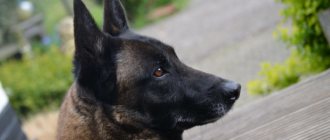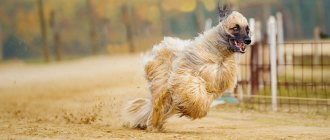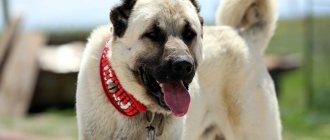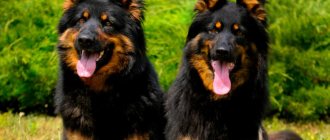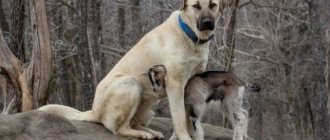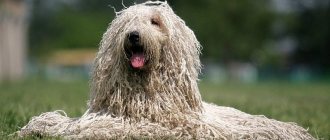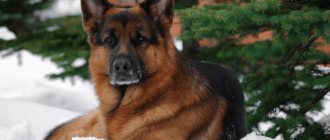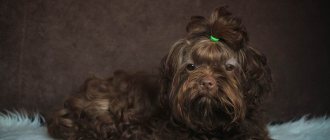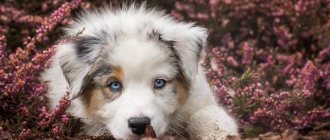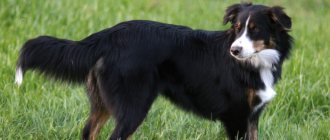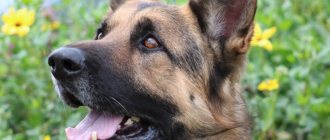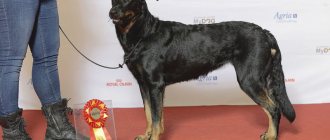The South Russian Shepherd is one of the few dog breeds bred on the territory of the former Soviet Union, and therefore is especially beloved among us. Gorgeous long white hair, the wayward character of the dogs, excellent guarding qualities - these are just a few of the facts that characterize this breed. This article will tell you why the South Russian Shepherd is interesting, how to properly care for its coat and what to pay attention to when raising a dog.
Origin of the breed
The Old Russian Shepherd has been known for several centuries. Its distant ancestor, the Asturian Shepherd Dog, was brought from Spain to the Crimea back in the 17th century, where it gradually mixed with local herding dogs. A lot of work on breeding the breed was done by sheep farmers, who bred dogs in the semblance of modern nurseries, selecting the largest and strongest ones to guard the sheep. This is how the breed of Russian shepherd dog emerged, which was noted at exhibitions at the beginning of the 20th century.
After the revolution and civil war, the breed was in danger of extinction. It was restored with great difficulty, thanks to the dogs preserved by shepherds in remote areas. In the 30s, the name of the South Russian Shepherd was officially approved, and the first breed standard was drawn up. During World War II, the Russian Shepherd almost disappeared again - at the end of the 40s, there were only a few dozen representatives of the breed in the entire country.
South Russian Shepherd Dogs were originally bred to guard herds of sheep.
It was very difficult to revive the South Russian Shepherd. Experts had to cross the surviving dogs with other breeds similar in appearance. But it has not yet been possible to restore the breed in full. In modern conditions, professionals and amateurs work together to breed and improve the South Russian Shepherd.
Breeding German Shepherds
Breeding animals, including German shepherds, is a very responsible and labor-intensive process. Ignorant people should not do this, as there is a possibility of harming the health of both adults and puppies.
During pregnancy, the female should receive special care from the owner, and give birth under the close attention of an experienced dog breeder or veterinarian.
Before mating shepherd dogs, it is necessary to carry out kerung (breeding selection). This will help determine whether a particular individual is suitable for breeding or not.
How is breeding selection carried out?
- An invited specialist (kermaster) checks the mark and examines the animal’s documents for their authenticity.
- The kermaster enters the necessary information about the dog into the kercard.
- Next, the specialist examines the dog and checks it for congenital defects. After this, the pet is weighed, height and chest volume are measured.
- After this, you need to observe the dog’s behavior during the shot: normally, the shepherd will not show aggression, worry or get scared.
- The “German” must pass the test of courage and acumen. To do this, invite a person who will act as a target. The dog must grab his sleeve, demonstrating a strong grip, and withstand blows from the stack. As soon as the owner gives the command, the dog must immediately stop grabbing.
- It is important to evaluate a shepherd based on external parameters. To do this, the dog must stand in a stance and then move in a circle together with the owner. This is necessary for the kermaster to study the nature of the animal’s movements.
After all the events, the German Shepherd is awarded Kerclass 1 or Kerclass 2. The first - if the dog can participate in breeding without restrictions, and the second - if the presence of a kermaster is necessary for breeding work.
Breeding selection is possible when the animal reaches 18 months. After 1-2 years, you need to repeat the kerung procedure.
It is important that the kerung be handled by a specialist who can study the pedigree of the individuals and follow all the rules. If dogs are each other's closest relatives, this will have a detrimental effect on the offspring.
If one of the parents has some kind of congenital defect, then the second parent must be chosen without it so that this trait does not become established in the puppies. Before mating, dogs are fully examined for diseases, including those that can be sexually transmitted.
Under no circumstances should you breed a female during her first heat cycle at 8-9 months of age. The ideal age for pregnancy is from 1.5 to 2 years. Typically, one female is used for breeding for no more than 9 years, males - without restrictions.
The fact that females come into heat twice a year does not mean that she can give birth twice a year. Usually girls give birth once a year, and the rest of the time they recover. It’s great if there is a gap of at least 300 days between births.
The average period for bearing offspring is two months, but if this is the female’s first birth, then the pregnancy may drag on a little. The duration also depends on the puppies: if there are many of them, the birth may begin earlier.
A dog in position needs care, comfort and affection from its owner. It is important that the expectant mother does not worry, does not engage in active physical activity and eats well. To do this, you can purchase super-premium food or holistic food marked “for pregnant and lactating dogs.” If a “German woman” eats natural food, the amount of animal protein and vegetables needs to be increased, but carbohydrates should be reduced.
From the 8th week of pregnancy, meat in the diet is slightly reduced, replenishing its amount with fish and cottage cheese. This is necessary in order to prevent calcium deficiency in the animal’s body.
Description of the breed
The fluffy shepherd looks quite unusual and impressive. The combination of large size with a shock of wool makes a strong impression. The shepherd dog owes its appearance to its occupation from past centuries. The large shaggy dogs guarding the sheep looked very much like their charges, which misled predators. This allowed the shepherd to gain the advantage of surprise when charging at the enemy. The modern breed standard includes the following characteristics:
- strong bones, lean, muscular build;
- high height - 62-66 cm at the withers, average weight - from 35 kg;
- the chest is quite wide, deep, tucked in the stomach;
- the skull is elongated, wedge-shaped, with a smoothed transition from the forehead to the nose;
- triangular drooping ears, set high and medium in size;
- small, wide-set, oval-shaped eyes, brown in color, from dark to light;
- the nose is straight, tapering towards the end of the muzzle, black in color;
- powerful jaws with large white teeth, scissor bite;
- the neck is straight, strong, without dewlap, equal in length to the head;
- the coat is hard, thick, slightly wavy, of the same length throughout the body - from 10 cm;
- the undercoat is well developed, soft, light in color;
- coat color is white, light with a yellowish tint, gray with tan;
- the tail is lowered down and may be slightly curved at the end.
The shaggy appearance and color made the South Russian dogs invisible among the sheep, which had a surprise effect on predators.
The difference between the sexes is pronounced - males are larger and more massive, with a shorter body. Bitches are slightly lower at the withers, but have a more elongated body. The general impression of the dog is deceptive - it seems massive and clumsy due to its fur. But in reality it is a fast and agile animal with long strong legs.
Additional Information
Yuro should not be left alone with the child, especially when the upbringing process has not been completed. At the same time, the dog associates its owner with the leader of the pack. Accordingly, a family is its members and they need to be protected. On the one hand, the dog is not distinguished by its good disposition, but on the other hand, it is very devoted, faithful and capable of self-sacrifice (subject to proper socialization).
It is noteworthy that the YuRO chooses its owner for itself. When walking with her, you must not enter into conflicts with others, otherwise the dog will see the person as an enemy and may even cause harm. Also, such a pet is not the best gift for a child, because at the slightest disagreement with his parents, the dog will protect his little friend.
Character
The South Russian Shepherd was bred as a service guard breed, capable of fighting and protecting the herd from predators. Therefore, the predominant valuable qualities in the selection were aggressiveness, fearlessness, and determination. These animals are distinguished by their intelligence, capable of assessing the situation and quickly making independent decisions.
Another striking feature of these dogs is their complete devotion to their owner. The South Russian Shepherd Dog obeys only one person, unquestioningly carrying out all his orders. She will protect the owner from any threat, will never show aggression towards him, and will also take under her protection those whom he points to. Therefore, keeping these animals in the family is quite safe, despite their natural aggressiveness.
The South Russian Shepherd chooses only one owner from the family; it regards the remaining members only as an object of protection
Such boundless devotion also has a drawback - the Russian Shepherd is rarely able to accept a change of owner. If the dog is handed over to a new owner, it will not trust his authority, and the strong melancholy from the loss of the old owner will affect the health of the animal. Also, the shepherd is unable to forget the person who caused harm to its owner - such a person will forever become an enemy for the animal.
Diseases and life expectancy
Despite their physical strength and endurance, South Russian Shepherd Dogs are susceptible to a number of diseases. These include both congenital and acquired pathologies:
- hip dysplasia;
- cataract;
- turning of the eyelids;
- gastric volvulus;
- allergy;
- osteoarthritis;
- lack of teeth;
- epilepsy.
Average life expectancy is 12-15 years. Early death can occur from improper care, injury and lack of physical activity.
Training
When guarding a herd, Russian Shepherds remain alone for a long time, so they are able to make decisions without human intervention. This makes their character independent, and training is quite difficult, especially for an inexperienced person. The dog regularly tests even its owner for strength, and therefore requires a strict attitude towards itself.
Visually, thick and long hair makes South Russian Shepherds clumsy, although they are very dexterous dogs
Raising such a pet requires a lot of patience and strong will, and the consequences of poor training can make the dog dangerous to others. Therefore, before getting a South Russian Shepherd, you need to objectively assess your strengths; understand whether you can train the animal correctly and pay enough attention to it.
How to train
The characteristics of the breed affect not only the physical development and maintenance, but also the upbringing of the animal. Successful training begins with early socialization of the puppy. The owner must teach the Yuzhak to obey orders, otherwise the innate aggression will get out of control. It happens that shepherd dogs suppress the personality of the owner, ignore commands and dominate. This leads to dire consequences.
The training of the South Russian Shepherd should be carried out by a professional dog handler. If an unprepared person gets down to business, he can make a number of fundamental mistakes that will lead to the formation of a pattern of aggressive behavior.
Don't try to train your dog yourself! If unsuccessful, the dog cannot be transferred to another owner or sent to a shelter.
Security qualities
The South Russian Shepherd Dog considers its main duty to protect the territory that its owner has entrusted to it. Modern representatives of the breed are excellent guards. These dogs have acute hearing, a sensitive sense of smell, and feel confident even in a large security area. Russian Shepherds are often bred as guard dogs for permanent keeping in suburban areas.
The South Russian Shepherd is great for guarding a country house
The only drawback of the animal can be considered increased aggression, which at times turns into bitterness. This dog will perfectly protect the yard from burglars, but it can also cause harm to neighbors or children who carelessly enter the territory.
Nutrition
It is strictly forbidden to overfeed your dog. They eat small portions twice a day. The portion should be calculated according to the following formula: per 1 kilogram of animal weight there should be 50 grams of food and a lot of clean water.
The dog needs a balanced diet with sufficient amounts of proteins, fats, carbohydrates and fiber. Be sure to include in the diet:
- lean meats (turkey, chicken, beef and veal);
- cottage cheese and other fermented milk products;
- fresh vegetables and fruits;
- boneless fish;
- chicken eggs;
- porridge cooked in broth.
You should not give foods that cause bloating: corn, peas, cabbage and potatoes. It is also not recommended to feed fatty foods and tube bones. Dry food of the highest quality is allowed in small quantities.
Family care
Despite its cautious and independent character, the Russian Shepherd is quite sociable and enjoys communicating with its family.
Submitting to the will of the owner, the dog will never harm a family member, but his attitude towards other people is condescending, without respect. The dog treats other pets in the same way, considering himself the leader of the pack. If her right to the hierarchy is challenged, other animals could be seriously harmed.
IMPORTANT: If there are small children in the family, the dog will not touch them, but will not be patient with their games. The dog may carelessly push the baby or snap at his obsessive attempts to pet him. It is also dangerous to give a shepherd puppy to a small child or teenager - he will not be able to properly raise and control the dog, so it will quickly become uncontrollable.
The South Russian Shepherd must be brought up strictly, otherwise you may end up with a dangerous and uncontrollable shepherd.
Attitude towards children
Dogs of this breed are suitable for families with small children. The specificity is to initially explain to the dog what place she and the child occupy in the family. The South Russian Shepherd is a strong and independent dog. She just needs a strong and confident owner. With such a tandem there is no danger for children.
It is important to remember that it is not recommended to leave a large dog alone with small children for a long time. In the absence of control, the behavior of both is very unpredictable. It is difficult to predict the reaction of a four-legged pet to new and unusual actions of a small person. This, by the way, applies to absolutely all dogs.
Health
The breed was bred to live outdoors at any time of the year. For this purpose, the strongest and hardiest individuals, reliably protected by warm wool, were selected for breeding over the years. For this reason, the modern South Russian Shepherd is distinguished by good genetics and excellent health.
Representatives of the breed live up to 15-17 years - a long time for a large breed of dog. Thanks to their strong immunity, animals almost never get sick, and their thick coat protects them from hypothermia in the winter months. An abundant undercoat also helps to avoid infection by fleas and lice-eaters - insects simply cannot reach the skin.
IMPORTANT: Health problems can begin from lack of movement. A herding dog needs serious exercise, long walks, and exercise. Otherwise, there is a danger of developing diseases of the cardiovascular system and skeleton.
Mating
Mating must meet the requirements for the mating process of large breeds:
- The first mating takes place at 24 months ;
- The mating period is between the 11th and 14th day after estrus (usually the third);
- Introducing dogs - in the territory of the dog;
- Time – preferably in the morning, after a long walk; It is not recommended to feed animals;
- Repeated mating - every other day.
Puppies
Small South Russian Shepherd Dogs are fluffy and clumsy, with sparkling eyes. Due to the special attitude towards the owner, puppies are handed over to new owners quite early. It is better not to take a puppy who is already four months old - his independent character has already begun to manifest itself, so it will be more difficult to establish the correct hierarchy.
After 4 months, a South Russian Shepherd puppy develops an independent character, which significantly complicates its upbringing
When choosing a puppy, you need to pay attention to its behavior. He must be active, inquisitive, and you can often see attempts to fight and dominate his brothers. You should not adopt a puppy of this breed if he demonstrates lethargic, phlegmatic behavior. Be sure to find out about the cub's temperamental characteristics from the breeder - this will help during training.
Learning ability
Shepherd dogs in general - South Russians are no exception - are excellent trainees. Their training is not difficult with the right approach. It is only necessary to exclude harsh methods and punishments.
You can teach a Yuzhak almost any command. You just need to take into account the size, age and temperament of the dog.
It may take literally a few repetitions to learn a new signal. It will take a little more time to consolidate the skill. There are no special secrets here - you need to periodically repeat and remind your pet what and how to do.
Care
When keeping a South Russian Shepherd, you will have to pay great attention to caring for its long hair. The dog must be brushed daily, first with a coarse brush, then with a comb with metal teeth, otherwise the soft undercoat will become tangled. Particularly careful care will be required during shedding, when the fur comes off in large clumps. It is very difficult to wash a dog entirely; it is not recommended to do this more than several times a year.
Both ready-made dry and wet food and natural food are suitable for feeding the dog. Despite its large size, the South Russian Shepherd requires relatively little food; overfeeding can lead to diseases. In order for natural nutrition to be correct, it is recommended that a diet be drawn up by a veterinarian.
IMPORTANT: It is better to choose ready-made food from premium brands, then you can be sure of the health of your pet. Complete feeds are verified in composition and calories, balanced in the content of vitamins and minerals, so natural food cannot be given in addition to them.
Characteristic
| Good attitude towards children | Attitude towards strangers is average (rating 3/5) | health (rating 3/5) |
| Picky eating habits are low (rating 4/5) | training (rating 5/5) | Shedding average (rating 3/5) |
| care needs (rating 3/5) | The need for communication is sufficient (rating 4/5) | Friendliness is good (rating 4/5) |
| activity (rating 5/5) | Intelligence High (rating 5/5) | Noise is average (rating 3/5) |
| Security qualities are high (rating 5/5) | Cost of maintenance is above average (rating 2/5) | Price is average (rating 4/5) |
Price
Depending on the pedigree, the price for a South Russian Shepherd puppy ranges from 250 to 1000 dollars. If you buy not through a kennel, but directly from a breeder, you can buy a dog that is relatively inexpensive. But in this case, you need to carefully study the reputation of the seller to avoid the risk of getting a puppy with defects or diseases. Animals for exhibitions are purchased only through large nurseries, where all documents are provided.
The breed standard allows for a white coat with a yellowish tint
Dog names
The name should be short and succinct. Until the animal gets used to the name, it needs to be said many times a day. Common names for girls:
- Aina;
- Bayra;
- Vega;
- Gray;
- Horta;
- Rona;
- Fry;
- Shetty.
Nicknames for boys:
- Iron;
- Aston;
- Bosco;
- Graph;
- Jeff;
- Larry;
- Marseilles;
- Falcon;
- Fred;
- Yard.
You can choose a nickname in two ways - use lists of the most common names for this breed or use myths and legends, taking the names of heroes from there.
The Shepherd is a reliable protector and faithful friend
Reviews
Konstantin:
We have had a lot of dogs on the site, the Yuzhak is the best guard. Very loyal, but really aggressive towards strangers. There have been several cases of people ignoring dog warnings and getting bitten. Although for the most part our dog only growled at the person who came into the yard. Choose a southerner only if you are sure that you can raise him correctly.
Yuri:
An unusual, beautiful dog, it protects its territory with great zeal, is obedient and patient with its family. It is not difficult to care for, apart from combing the fur, it does not eat much. But she definitely needs to be kept strict, she has a stubborn character.
Valentina: The dog lived at our house for 14 years, then we moved him to the dacha. He loved and protected everyone in the family, did not trust strangers, and obeyed only his father. A very beautiful breed with long hair that flutters while running, the bangs covering the eyes. The character is complex, but if raised correctly from childhood, the dog will be obedient.
Interesting Facts
Owners of shepherd dogs notice many interesting behavioral features in them, and experienced hereditary breeders can share unusual facts from the history of the breed.
- Despite the fact that the ancestors of the German Shepherd are more than 3 thousand years old, this is one of the youngest breeds - it is just over 100 years old.
- Despite their age, Germans are one of the most popular dogs on the planet. Their appearance is familiar to everyone, and, according to observations, when most people hear the word “dog,” they think of a German shepherd.
- Shepherds are excellent actors. Thanks to their high intelligence, they are often featured in films - they cope well with roles, listen to commands flawlessly, repeat the same type of actions many times and are able to work for many hours in a row.
- German Shepherds are not only police officers, but also soldiers. They participated in wars and were in many hot spots, where they provided assistance to the wounded, carried food, water and medicine.
- After the Great Patriotic War, they wanted to rename German shepherds, but none of the new names took root for a long time. Moreover, even the association with recent enemies did not spoil the attitude towards these intelligent and noble dogs.
- Shepherds can become foster parents. They “adopt” not only other people’s puppies, but also kittens, wolf cubs, fox cubs and even tiger cubs.
- The bite force of a shepherd is 80-100 kilograms, which can easily break human bones and even kill. True, they attack only when threatened.
- Almost every country in the world has a story about the famous shepherd hero, which is why monuments to them have been erected in many cities.
